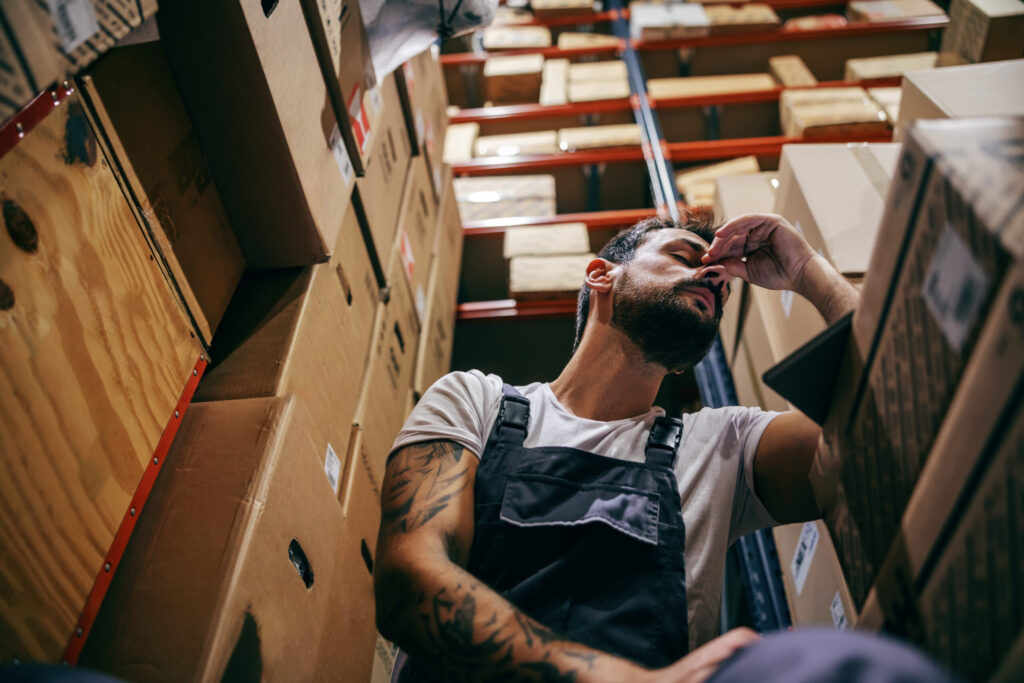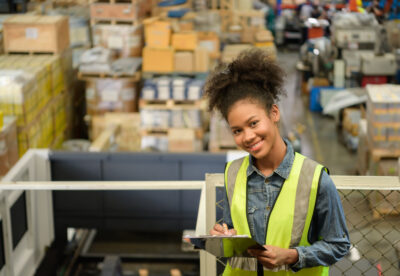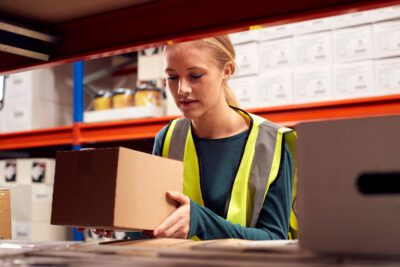Webinar Registration: The P2G Advantage
Webinar Registration: The P2G Advantage LEARN MORE
How to Make Warehouses Less Stressful with Automation and Robots
Mary Hart, Senior Content Marketing Manager

Warehouse managers nationwide are struggling to recruit and retain talent amidst the tightest labor market in decades, and the stressful nature of warehouse work doesn’t help with encouraging people to apply and stay in warehouse jobs. SupplyChainBrain recently noted that in a study published by TRĒ House, a marketer of hemp-derived products and other items, the warehousing and storage industry scored 28.92 out of 100. That score made warehousing and storage the most stressful sector analyzed by the organization.
In the warehousing and storage industry, everyday work stress is compounded by low hourly wages, the need for second or even third jobs, and draining, tedious work walking up and down aisles pushing or pulling heavy carts. Adding to that stress are growing volumes that affect ongoing performance metrics, putting pressure on workers to meet SLA deadlines. All of this stress not only dampens morale but can also lead to reduced productivity and increased errors — a cost no warehouse can afford to bear.
With all of the stress in a warehouse, associates and managers alike can feel like they’re in the middle of a never-ending hurricane if they’re still using manual warehouse operations. However, sunlight is in the forecast for stressed-out warehouse workers in the form of warehouse automation and robotics.
6 Ways Robots Ease Warehouse Stress
When you think of warehouse automation in the form of robots, you might think of something that’s going to replace warehouse workers. That’s not the case. Instead, robots like autonomous mobile robots (AMRs) work alongside and partner with human associates to create a more pleasant and far less stressful work environment. Let’s look at how they help.
Reducing Physical Strain: Robots take on the physically demanding transport tasks traditionally shouldered by humans, letting associates focus on tasks that use their brains instead of walking up to 15 miles in a warehouse each day pushing a 200-300 pound cart. By automating these processes, warehouses can reduce the physical toll on workers, leading to a healthier, happier workforce.
Increasing Efficiency: Automated systems are designed for speed and accuracy. They work alongside human associates to improve efficiency in picking, sorting, and processing returns at a rate that manual warehouses can’t match. This increased efficiency helps keep seasonal volume increases like peak manageable and ensures that customer satisfaction remains high.
Enhancing Safety: Robotics technology comes with advanced safety features that minimize workplace accidents. AMRs, for example, have precise navigation and collision avoidance systems, making them safer than manual transport methods. In fact, AMRs are designed with safety and security of the human workers in mind and undergo extensive testing and assessment both pre- and post-production. One Locus Robotics’ customer reported a 77% reduction in workplace injuries after deploying LocusBots, as well as fewer no-shows.
Alleviating Mental Load: With robots handling routine and repetitive tasks, workers are free to focus on more complex, engaging, and rewarding work. This shift can lead to greater job satisfaction and less mental stress. With training, staff become qualified to take on higher-value responsibilities. Upskilling for associates that work alongside robots might include:
Hands-on robot operation
Data analytics certification
Mentorship programs
Performance incentive plans
This career development boosts morale and retains talent. Workers with in-demand skills receive increased compensation and job security.
Creating Consistent Work Hours: Warehouse automation can lead to more predictable work hours, reducing the need for overtime and the stress of unpredictable schedules. This stability is crucial for workers' mental and physical well-being.
Promoting Collaboration: AMRs aren't designed to handle all tasks alone – instead, they work best when working alongside humans. Humans supply critical thinking and oversight while robots provide the transportation and carrying power.
While warehouse automation delivers impressive productivity and accuracy, machines can’t replicate human judgment, creativity, and emotional intelligence. When you’re bringing on automation and robots to your warehouse, frame it as enhancing your associates’ abilities and not at all replacing them.
Humans + Robots = Less Stress
Remember: Your workforce remains your warehouse’s greatest asset and people work best in a less stressful environment. Easing the stress in your warehouse requires bringing on warehouse automation to take over hazardous and repetitive manual tasks, freeing associates from physical and mental burdens. Robots handle heavy lifting and transport to alleviate bodily strain and work alongside humans to increase efficiency. Associates relieved from grunt work can upskill into data analysis, equipment maintenance, and supervisory roles for more job satisfaction.
The journey toward a less stressful warehouse is not just about implementing technology; it's about creating a partnership between humans and machines that elevates the entire operation. By embracing warehouse automation, facilities can alleviate physical strain, improve efficiency, and foster a collaborative, rewarding work culture. This shift not only benefits the well-being of associates and managers but also drives operational success and sustainability.
Locus Robotics offers autonomous mobile robots known as LocusBots that are designed to work alongside human associates. By integrating our innovative solution, you can effectively ease the physical and mental burdens of your workforce, leading to a more efficient, safer, and happier work environment. Want to explore how we can help you turn the tide against workplace stress? Let’s talk!




